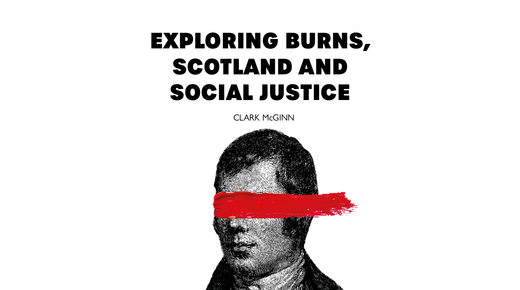Exploring Burns, Scotland and Social Justice
A Quick-Fire Q&A with Clark McGinn

A Quick-Fire Q&A with Clark McGinn
Join us as Clark Mcginn, author of Burns and Black Lives takes part in our series of quick-fire Q&As!
What is a quick-fire Q&A?
We have our interviewee pick a number at random and we ask them the general question listed next to it.
Shortly after we switch to asking book-specific questions, to give you a brief insight into our wonderful writers and their books.
_____________________________
What are your three favourite books?
Bleak House for novels. For English poetry, John Donne. And for modern books, A Gentleman in Moscow.
Although if I was doing Scottish wise, they'd all have to be from Ayrshire. Well, of course Burns would have to be the poetry and George Douglas Brown’s House with the Green Shutters which is a crazy, gothic book which rips apart cozy Scotland.
What would you say your spirit animal is?
Oh, golly, I've been asked that a thousand times and I really don't know. I can never find anything that's irritable enough!
A cat maybe, I've always liked cats. Maybe just an ordinary moggy.
What's your favourite thing about Scotland?
Oh, the people.
Followed very quickly, particularly Glasgow, by the buildings. You know, if you were transported, just dropped down from a spaceship into St Vincent Street, you’d know where you were. Firstly, by the people, somebody probably saying ‘Where did you come from, Jim, oot ma way!’ And then you just look up at those wonderful, confident buildings.
Confident people, confident buildings. That's Scotland for me.
If you could describe yourself in five words, what would they be?
Curious. Irritable. Friendly. Thoughtful. And irritable. Add generous in there maybe. Irritable and generous.
What was your favourite thing about writing this book?
My favourite thing about writing this book was that people think of Burns as either a poet or a force of nature. So, taking that poetry and his personality and looking at a social problem that still affects us today in terms of, not specifically slavery, but in terms of racism, of discrimination, of other things. Not necessarily to do with colour, but just in the broadest way.
You take Burns from 200-odd years back to today and seeing the stories he tells us, it was really quite powerful.
What emotional reaction do you expect people to have to the book?
I think it's going to be twofold. I think, first of all, the first thing you're going to hear is people say, ‘That’s not the Rabbie I know’, but it isn't the Rabbie we know because over the hundreds of years, we've put a protective wrapping round him and polished it up every January 25th.
So, I think that first emotion will be ‘He's talking rubbish’, woke rubbish. But then as people read it and look through the black people Burns saw and met in his lifetime, the books that he read in his library and then coming to that and saying, why didn't he do more? It's just a big question. And for me, that was the most important thing. When you say, why didn't Burns do more? Why don't we all do more to solve the big problems in life? And that's where people come back round in emotion. I hope.
How do you plan to celebrate the publication of this book?
It's going to be coming out in the Burns season. This year, I’m doing Immortal Memories at Burns suppers ranging from Toronto and New York, to London and to Glasgow. Dotted about here and there. So I hope that it will be a subject that people want to talk about, as well as enjoying the traditional, convivial, happy atmosphere, all getting round together on a really cold January night and celebrating Robert Burns.
What's your favourite part of the book? Is there a chapter or a section that you like best?
It’s been very enjoyable. I think, for me, the really interesting thing was looking at the black men and women who lived in Ayrshire at the time of Robert Burns. I don't think anybody's ever thought about that before that.
An Englishman would be an oddity! You wouldn't see black people, but they were there. There were servants, there were workers. Burns actually attended a christening in Mauchline Church where a young black man was baptised into the Church of Scotland. He was in the same room as a black person. It’s not as distant as you think.
And so, for me, so much of what we write about slavery, because of the way the records were kept and because of the horror of it, we never really hear the individual pain and suffering of the historical people. And so for that chapter, I found real-life people, included as you can imagine them, walking down the high street now, walking down your high street now.
That for me was evocative and something I'd never, ever considered.
Why did you choose the cover?
Because it’s provocative. We talked about what people's emotional response would be. And when we had ‘Black Lives Matter’, we had some very, very good outcomes and some very poor outcomes as we look back historically, like all human endeavour. People overreacted. So you can see immediately why the Colston statue or the Milligan statue in Bristol and London would be targeted. But then all of a sudden, Queen Victoria, Robert Burns, any historical figure seemed to be attacked for the problems they faced. So that really is a picture that sits there and makes you think, hang on, is that right or is that wrong?
And I hope that’ll make people read the book and, most of all, make their own minds up.